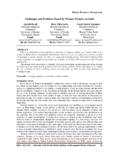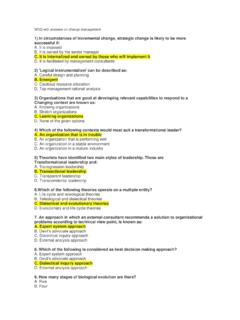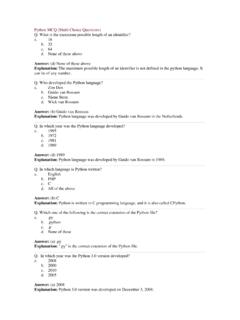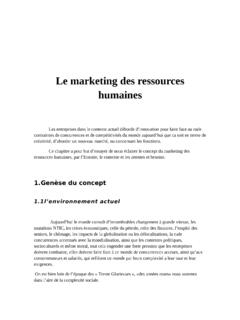Transcription of MCQ for MBA Sem III 305 OSCM Logistics Mgmt
1 1 MCQ for MBA Sem III 305 OSCM Logistics Mgmt Syllabus 1. The Principles of Logistics : Definitions & Significance of Logistics . Logistical System of Services Elements of Logistics , Distinction between Procurement Logistics , Production Logistics & Distribution Logistics , Service Level Logistics & Corporate Strategy, Supply Chain & Networks (7+2) 2. Logistics Systems: Logistical infrastructure, Basic Terminology, Types & functions, Transport infrastructure & superstructure, Transport Routes & Transport networks, Logistics Real estate, Logistic parks & freight villages, Information infrastructure & communication infrastructure, Telecommunication infrastructure, Satellite systems & Satellite navigation (8+2) 3.
2 Transport systems & Logistics services: Transport Basics, Significance & Development, Modes of transport technologies, Transport value & Transport affinity, Road Freight Transport, Rail freight transport sea freight transport, Inland water way transport, Air freight transports, pipeline transport (8+2) 4. Logistics Service Providers: Carriers & Forwarders, courier, Express parcel & mail service providers Systems, Service Providers & Contract Logistics Providers. IT in Logistics , communication standards, identification standards, Classification of IT in the fields of Inventory & Warehousing (7+2) 5.
3 Warehousing handling & picking systems: Warehousing , handling & picking systems, Warehousing Basics, Storage facilities, Static Storage Systems, Dynamic storage systems, Conveyors, Discontinous conveyors, Continuous conveyors, Sorters, Packages, Loading units & Load carriers, Picking & Handling. WHOrganisation, Inventory Stock & Provisioning mgmt. [5+2] MCQ s 1. ____ is not a part of basic systems of codifications. a. Alphabetical System b. Numerical System c. Colour Coding System d. None of the above 2. _____ and physical distribution are the two major operations of Logistics .
4 A. Supply Chain Management b. Materials Management c. Logistics Management d. None of the above 3. Which of the following is not a component of 4PL? a. Control Room (Intelligence) b. Resource Providers c. Information d. Recycling 4. Which of the following is not a part of Supply chain Management system? a. Supplier b. Manufacturer c. Information Flow d. Competitor e. Customer 5. _____ includes design and administration of systems to control the flow of materials, WIP and finished inventory to support business unit strategy. a. Logistics Management b. Materials Management c.
5 Bill of Materials d. None of the above 6. _____ is the time that elapses between issuing replenishment order and receiving the material in stores. a. Replenishment time b. Lead time c. Idle time d. None of the above 7. _____ is the task of buying goods of right quality, in the right quantities, at the right time and at the right price. a. Supplying b. Purchasing c. Scrutinizing d. None of the above 8. _____ is the provision of service to customers before, during and after a purchase. a. Customer Service b. Product Management c. Purchase management d. None of the above 9.
6 Buying according to the requirements is called _____ a. Seasonal Buying b. Hand to mouth buying c. Scheduled Buying d. Tender Buying e. Speculative Buying 10. The initial stage of the supply chain process is the _____. a. Sourcing Stage b. Organizing Stage c. Planning stage d. Directing Stage 11. The term supply chain management was first coined by _____. a. Frankel & Paulraj b. Peter Drucker c. Keith Oliver d. Philip kotler 12. In supply chain management, after planning, the next step involves _____. a. Developing b. Building a strong relationship with suppliers d.
7 All of the above 13. In Supply Chain Management, ATP stands for _____ a. Acquire Track & Perform b. Available To Promise c. Active Transport Protocol d. Access To Point 14. The purpose of supply chain management is to_____. a. increase the production level b. manage and integrate supply and demand management c. enhance the quality of a product and services d. provide satisfaction to the customer 15. _____is the primary activity of supply chain management. 2 a. Demand Management b. Supply Planning matching assets with demand c. Analytics Workbench of the above 16.
8 Another important purpose of supply chain management is to _____. inventory readily available b. delight customers and suppliers c. create warehouses at various locations d. to promote supply chain process 17. _____is mainly deals with all activities associated with the flow and transformation and information of goods from the stage of raw material to the end user consumption. a. Marketing Channel b. Production Line Chain management 18. In supply chain management, Inspection, scrap and repair are examples of _____. a. Societal Costs External Costs c.
9 Costs of dissatisfaction Cost 19. _____ is a Japanese term meaning continuous improvement a. JIT c. TQM d. Taguchi Map 20. EOQ stands for ____a. Electronic Obtained quantity b. Electronic Ordered Quantity c. Economic Order Quality d. Economic Order Quantity 21. Organisations or companies manage their supply chains through _____. a. Transportation modes internet d. Skilled Operators 22. The concept and philosophy of supply chain management evolved or emerged in _____ a. The 1960s b. The 1970s c. The 1980s 1990s 23. Full form of MRP in operations and SCM is _____ a.
10 Material Return Process b. Material Requirement Planning Repairing Planning Retention Planning 24. The concept of supply chain management originated in _____ discipline. a. Production Management b. Logistics Management d. Operations Management 25. In operations & supply chain management, Kaizen is a Japanese term meaning _____. a. Change for the better b. Continuous Performance c. Top-level quality d. Use of Kaizala app 26. According to Frankel, Bolumole, Eltantawy, Paulraj& Gundlach, (2008), these are the four functions identified as foundational operations, Logistics , supply management, _____.









